history reprints from VistaBooks
writen by John Muir, explorer, naturalist
John Muir (1838-1914). See Wikipedia for biography.
portrait of John Muir, conservationist, naturalist, writer,
mountaineer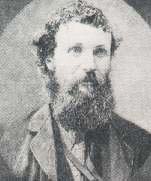
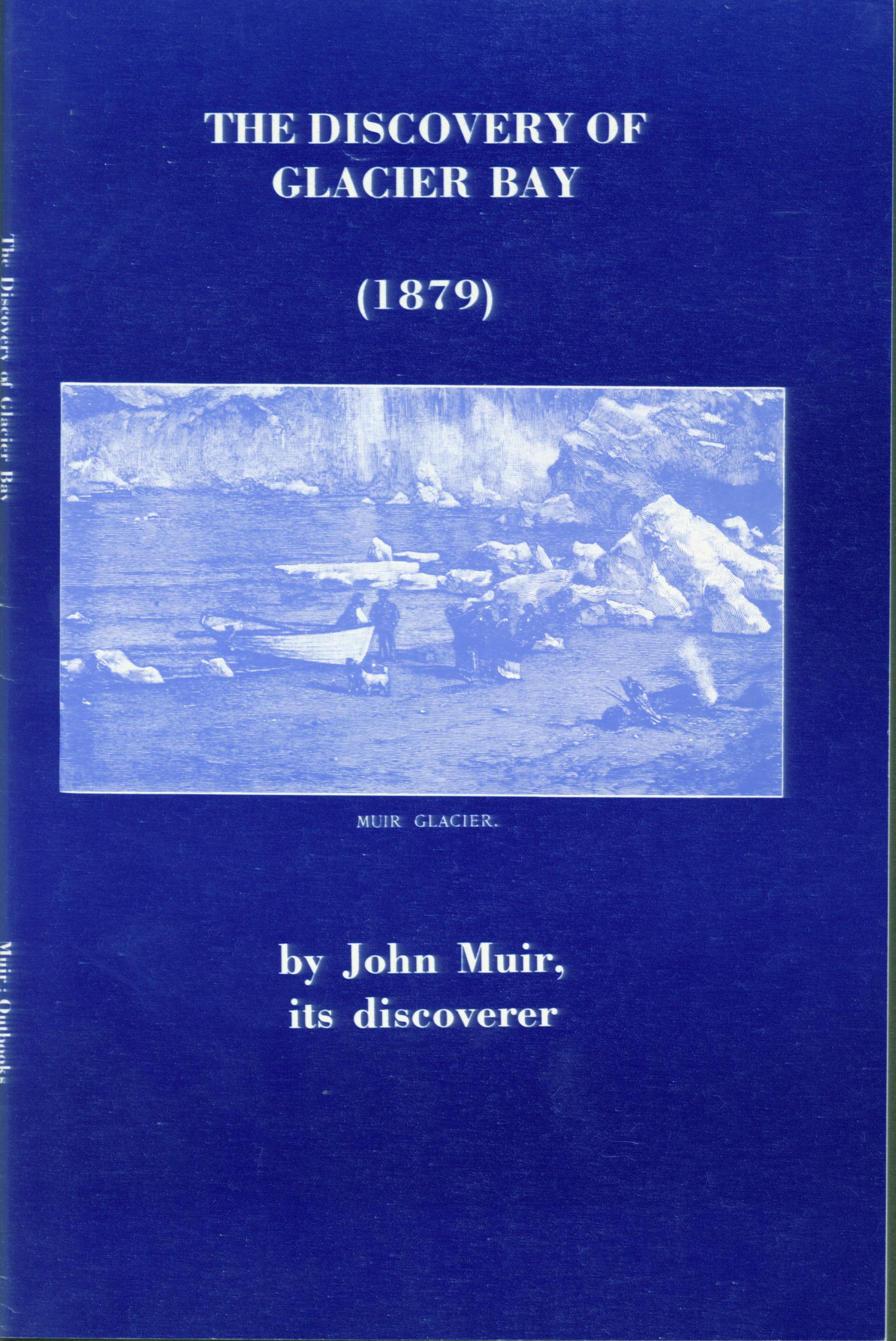
The Discovery of Glacier Bay (1879).
by John Muir, explorer/naturalist, its discoverer.
Adventures in a truly Alaskan Wild with ice floes, bergs, mountain peaks, Indians, canoe travel. Spending several "icy summers" in Alaska, Muir earned the name "Ice Chief", exploring Glacier Bay and its region. It was a fitting continuation to his involvement with glaciers, for he had developed the glacial origin theory for Yosemite Valley, in spite of the fact that there the glaciers were almost entirely gone. Here at Glacier Bay, no imagination was needed to understand the processes. Reprinted from Century Magazine. Engravings of ice and peaks abound in the book. 16 pages. See sample pages, illustrations.
ISBN-10: 0-89646-045-2. ISBN-13: 978-0-89646-045-4. Order #: VIST0045 paper$4.95.
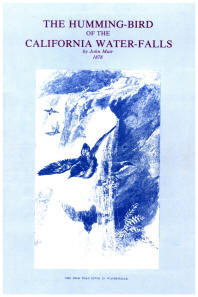
The Hummingbird of the California Waterfalls.
by John Muir, naturalist, "father of Yosemite National Park".
Reprinted from 1878. This has been called "the finest bird biography ever written". Muir's "waterfall hummingbird" is the water-ouzel, of course, now also called the dipper. Although Muir buffs and birders already know this, even they will enjoy reading or re-reading the story of this little bobber. Some might have seen this little bird, but without this article have not yet enjoyed the flyer/swimmer fully. As Muir's portrayal shows, much of the bird's intrigue is its physical elusiveness while remaining visually accessible. Enjoy this little story and enjoy this little bird. Foreword by former Chief Park Naturalist, Yosemite National Park. Period illustrations. 24 pages. See sample pages, illustrations.
ISBN-10: 0-89646-019-3. ISBN-13: 978-0-89646-019-5. Order #: VIST0019 paper$4.95.
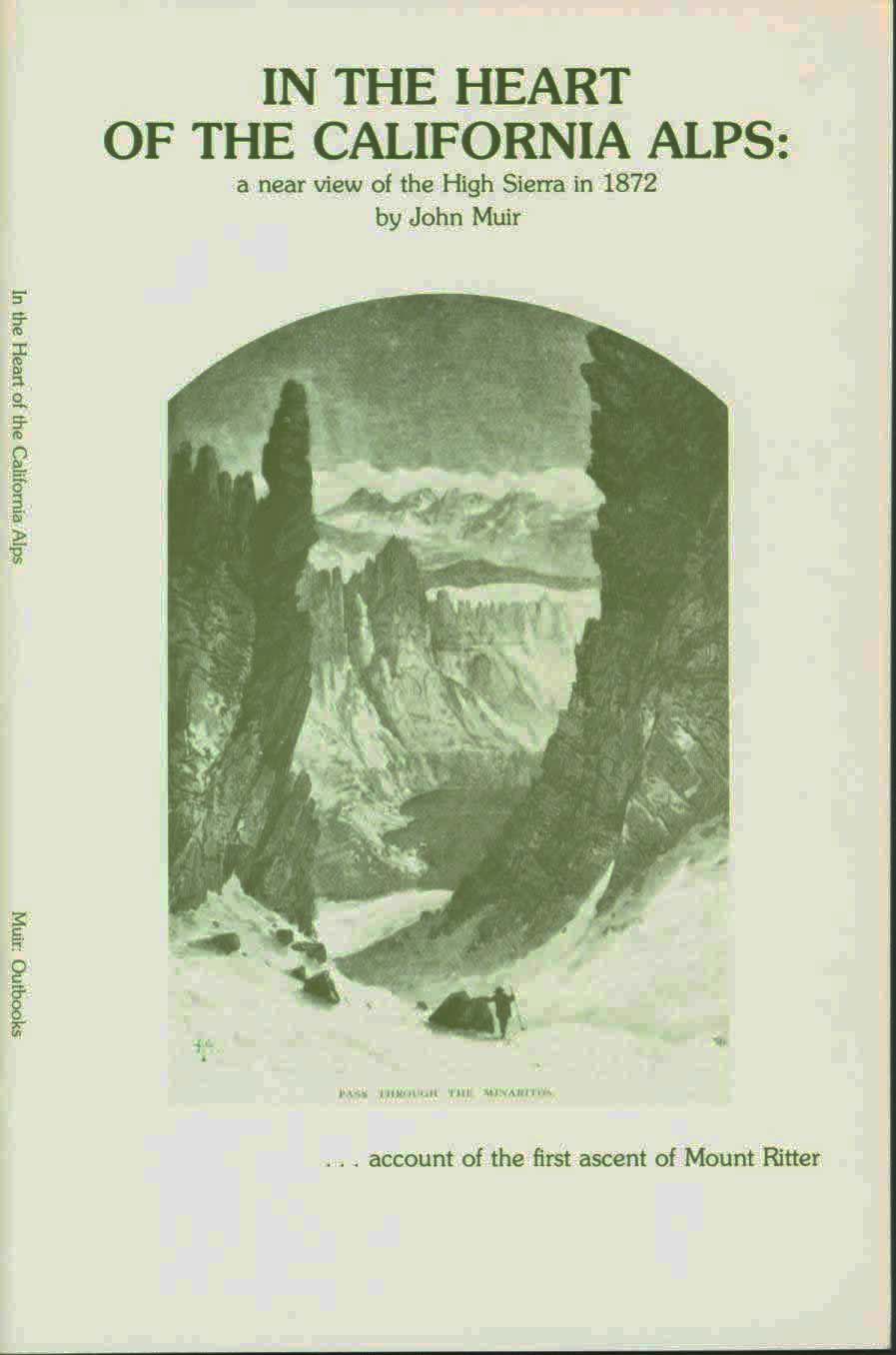
In the Heart of the California Alps: a near view of the High Sierra in 1872... account of the first ascent of Mount Ritter.
by John Muir.
 portrait of John Muir, conservationist, naturalist, writer,
mountaineer
portrait of John Muir, conservationist, naturalist, writer,
mountaineer
Account of the first ascent of Mount Ritter, October, 1872. Record of one of Muir's finest
mountain rambles and of the first ascent, a solo one, of this mountain in the Mammoth
Lakes country of the eastern Sierra Nevada. Combines natural observations with the
adventures and philosophical musings of a nearly fatal climb. Made from a base camp with
three artists who were left sketching on the Lyell Fork of the Tuolumne River late in the season, while Muir ventured into the Minaret country, in 1890 a part of Yosemite National Park but now in the Ansel Adams Wilderness of Inyo National Forest, near Mammoth, California. Three
illustrations of Mount Ritter and its region by one of these artists, William Keith, are included. (Keith became an eminent landscape painter, producing many scenes of the West including the Sierra, Yosemite Valley, Mount Shasta, the San Francisco Bay region, and more.) Drawings
by Muir are also included, as well as other period illustrations. Foreword by former
Yosemite Chief Park Naturalist William R Jones. 24 pages. See sample pages, illustrations.
ISBN-10: 0-89646-026-6. ISBN-13: 978-0-89646-026-3. Order #: VIST0026 paper$4.95.
KEITH AND MUIR:
William Keith (from St Mary's College of California website):
"A 19th-century leading artist and visionary in San Francisco, William Keith (1838-1911) is most known for his impact on preserving and sharing the California landscape through paint and brush. Saint Mary's College Museum of Art cares for the most comprehensive body of work created by this California Master Landscape Painter.
Keith arrived at Muir's cabin in Yosemite Valley with a letter of introduction in 1872, and a lifelong friendship quickly developed. The two Scottish immigrants took camping trips together in the High Sierra, saw each other when Muir was in San Francisco and helped inspire each other's work. The idea for the Sierra Club was first formed in Keith's studio during conversations with Muir, Dr. Joseph LeConte, the first president of the University of California, and Warren Olney, a prominent San Francisco attorney. Muir's concern with scientific accuracy reinforced Keith's early training as a wood engraver in encouraging him to reproduce the exact topography and details of a landscape early in his career. Keith had also already expressed a preference by 1870 to "study altogether from Nature," reflecting in part the admonishments of the influential writer John Ruskin."
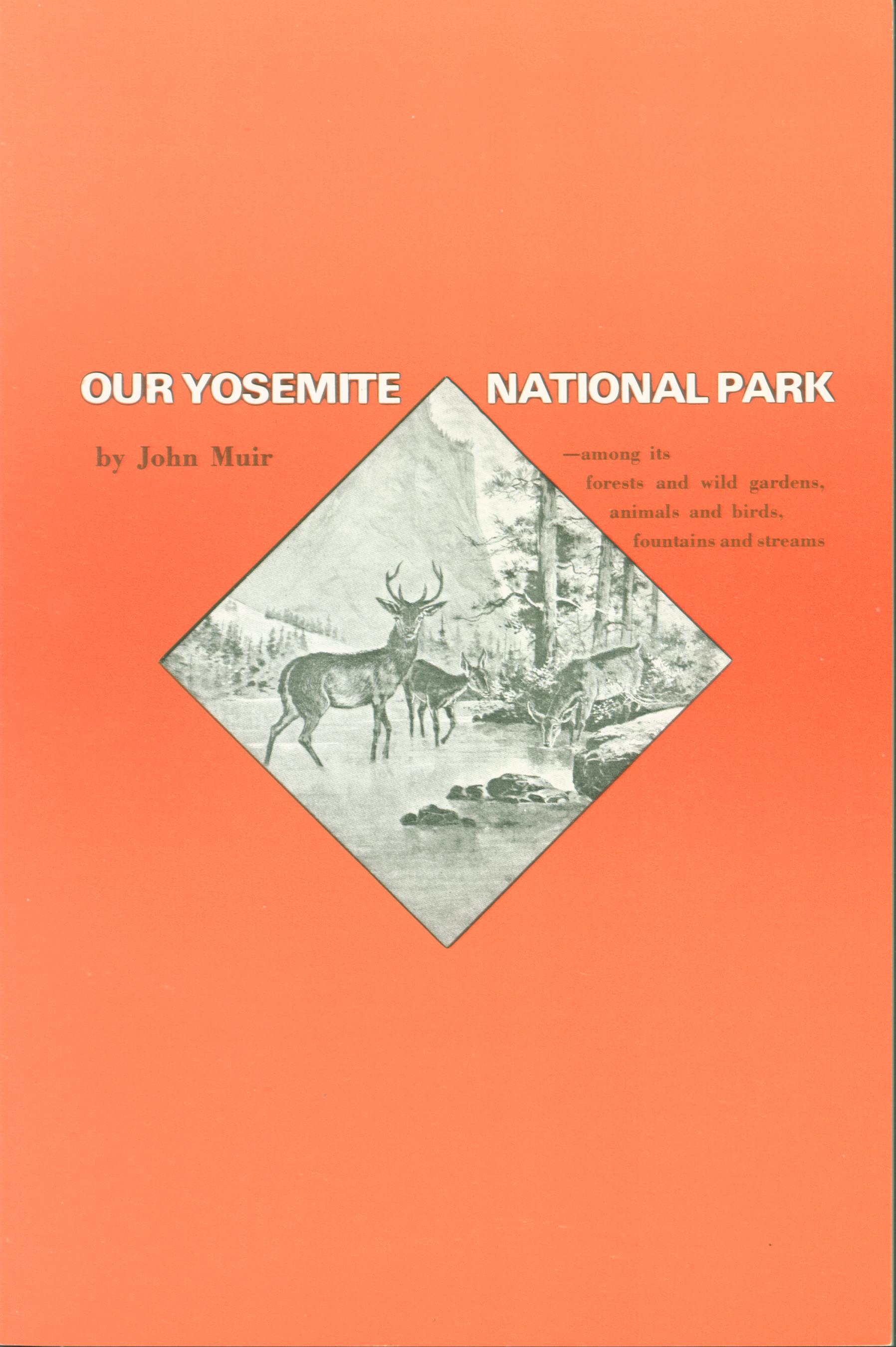
Our Yosemite National Park: among its forests and wild gardens, animals and birds, fountains and streams.
by John Muir, "naturalist, "father of Yosemite National Park".
At the turn of the century, John Muir described Yosemite National Park to readers of The Atlantic Monthly in the articles here reprinted. Just a decade before he had been so involved with the park idea that he became known as the "father of Yosemite National Park". Muir knew the park better than anyone else, and he had a gift for expression that keeps his fame and his works alive yet. The writing here is perhaps the best blend Muir gave of the Yosemite as a wild nature preserve. The ecological account is full, and we learn much of Muir's observations of the Yosemite birds, bears, and blossoms as well as its winters, earthquakes, glaciers, and forests. Period illustrations. 96 pages. See sample pages, illustrations,
ISBN-10: 0-89646-017-7. ISBN-13: 978-0-89646-017-1. Order #: VIST0017 paper$7.95.
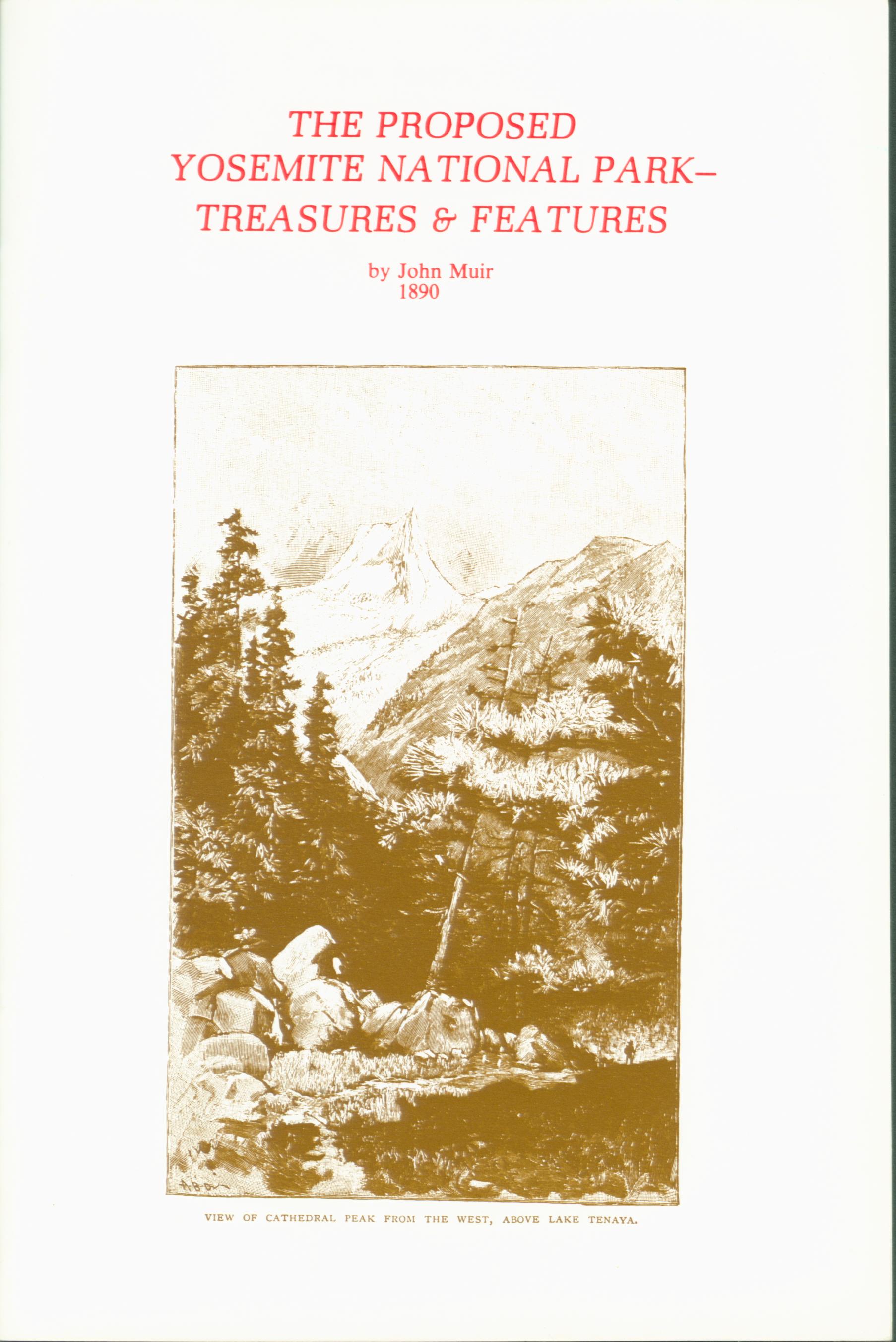
The Proposed Yosemite National Park--treasures & features, 1890.
by John Muir, writer, naturalist, conservationist, "father of Yosemite National Park'.
Perhaps the most important writing Muir ever did, for here he proposed a national park, which was soon established. He and his editor had hatched the scheme around a Tuolumne Meadows campfire, and so Muir became known as the "Father of Yosemite National Park." The writing is mostly descriptive, in Muir's magnificent style, covering the grand scenes, waterfall explorations, storm flooding, sequoias, glaciers, Hetch Hetchy Valley, and more. An included map shows Muir's proposed park boundaries, larger than today's, as one might imagine, for there was controversy about taking too much mineral land from potential production. Also shown is the watershed of the Yosemite Valley, as a major purpose of the new park was to protect the waterfalls of Yosemite Valley from upstream lumbering and sheep-grazing. At that time, Yosemite Valley was under state operation and the new park would not affect that; later, however, the valley was returned to federal management and the present park achieved its wholeness. Foreword by former Yosemite Chief Park Naturalist William Jones. Reprinted from 1890, with period engravings. 32 pages. See sample pages, illustrations.
ISBN-10: 0-89646-003-7. ISBN-13: 978-0-89646-003-4. Order #: VIST0003 paper$4.95.
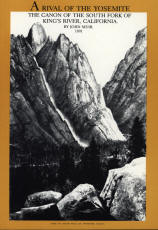
A Rival of the Yosemite: The Cañon of the South Fork of King's River, California.
by John Muir, explorer, naturalist.
As they had at Yosemite, Muir and his editor launched a campaign to get Kings Canyon set aside as a national park (some wanted to call it John Muir National Park), advising the law-givers to "make haste before it is too late". This writing was to be the stimulus. The park was not established, however, until 1940, when it was called Kings Canyon National Park. Muir's text is primarily descriptive, but as usual he includes personal adventures, in this case including a close encounter with a grizzly bear. Arguments for establishing the park are included, such as blocking grazing, lumbering, and mining. Text was reviewed by former Sequoia & Kings Canyon National Park Chief Park Naturalist and foreword is by former Yosemite Chief Park Naturalist. Period engravings, with map showing proposed park boundary. 24 pages. See sample pages, illustrations.
ISBN-10: 0-89646-010-X. ISBN-13: 978-0-89646-010-2. Order #: VIST0010 paper$4.95.
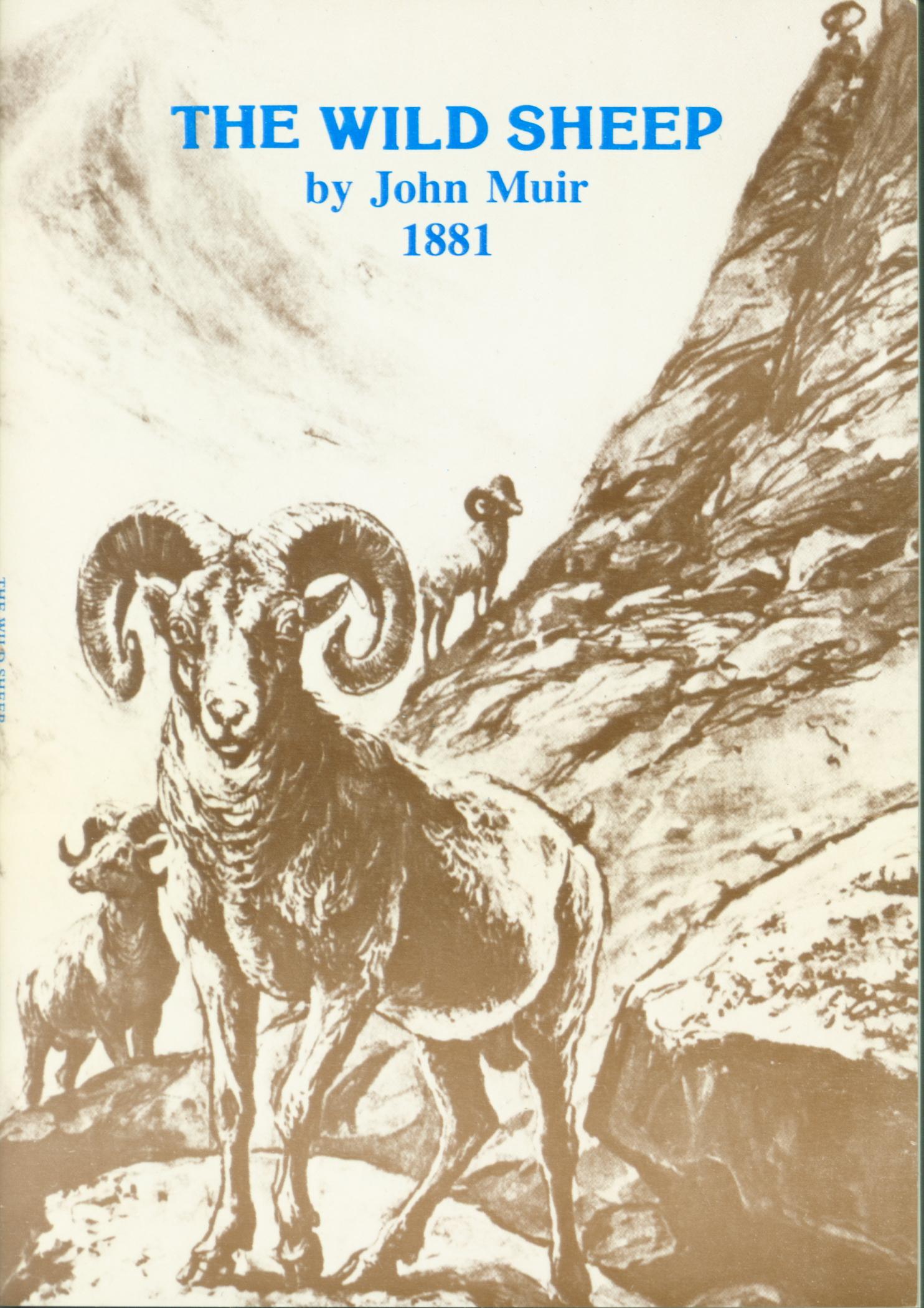
The Wild Sheep.
by John Muir, naturalist
Here the early naturalist-writer glorifies the mountain sheep, or bighorn, of the Sierra Nevada. In Muir's time (1881 is the date of this writing), sheep were still to be seen on his High Sierra rambles. He notes the distribution of sheep and their various species as well as their physical characteristics, and he also describes their mountain home where they lived, "the happy wanderers, perhaps relishing the beauty as well as the taste of the lovely flora on which they feed." But as always his finest sections are where he describes the sheep themselves and how they move about on cliff walls, fine four-legged mountaineers. Today, park and wildlife agencies are reestablishing populations of wild sheep in the Sierra Nevada and elsewhere, and we may thank Muir in part for this, as his writing helped keep our appreciation alive for them. Reviewed by Chief Park Naturalists at Yosemite and Sequoia and Kings Canyon National Parks. Period engravings. 32 pages. See sample pages, illustrations..
ISBN -10: 0-89646-017-7. ISBN-13: 978-0-89646-017-1. Order #: VIST0017 paper$4.95.
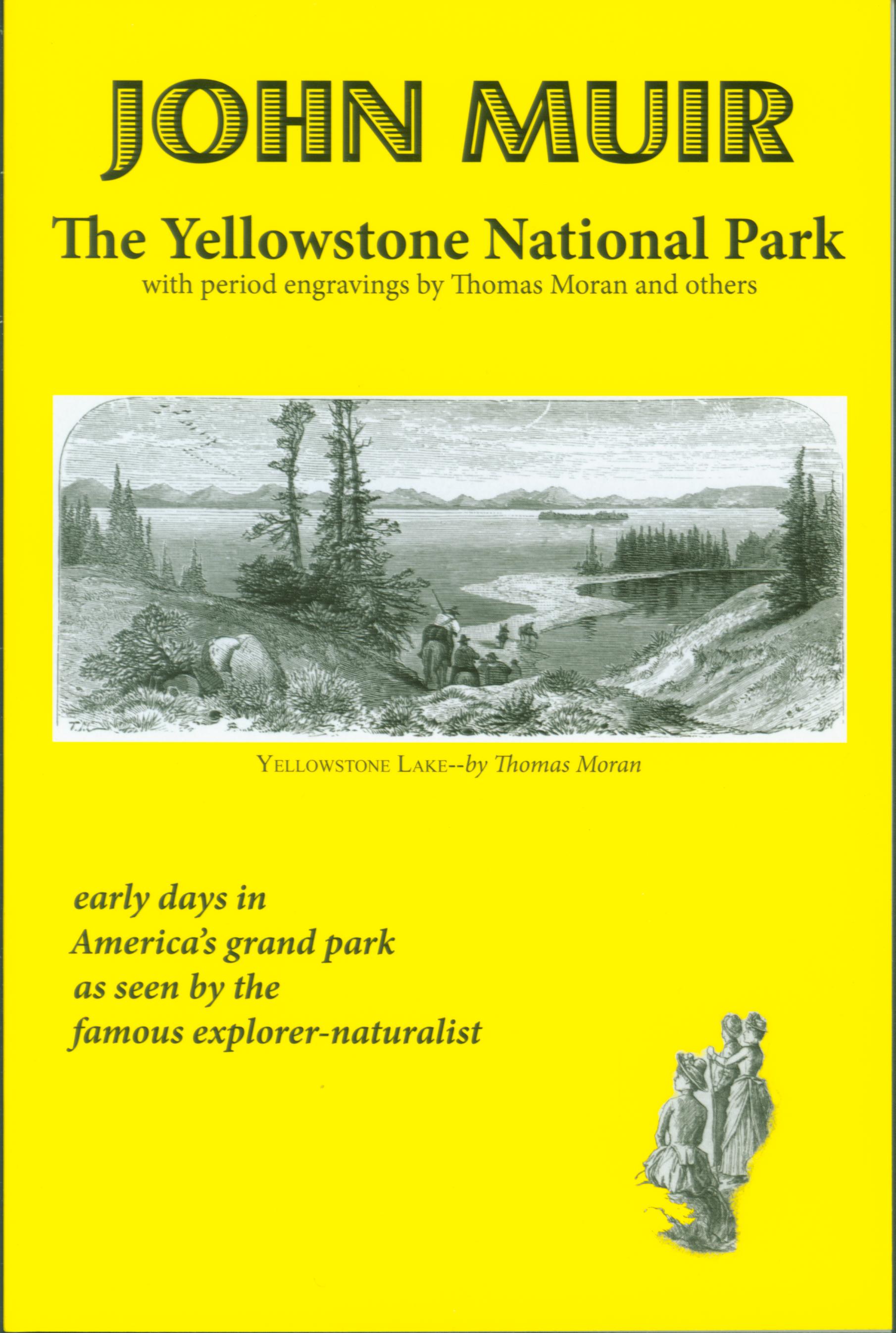
The Yellowstone National Park.
by John Muir, naturalist, national park advocate.
Here is what may well be Muir's most literary piece of nature writing, inspired not by
the Sierra Nevada he was more familiar with, but by the wonders of the Yellowstone region. The text tells of the park's geysers, lakes, mountains, animals, flowers and trees,
petrified forest--of the "blessed old Yellowstone Wonderland." It is the source
for his oft-quoted phrase:
"Climb the mountains and get their good tidings. Nature's
peace will flow into you as sunshine flows into trees.
The winds will blow their own
freshness into you, and the storms their energy, while cares will drop off like autumn
leaves."
Tips on how to travel in the park around the turn-of the-century are
included! Illustrated with drawings and engravings by Thomas Moran and others. 80 pages, 6 x 9, coated stock.
See sample pages, illustrations.
ISBN 978-0-89646-101-7. Order #: VIST0101 paper$8.95.
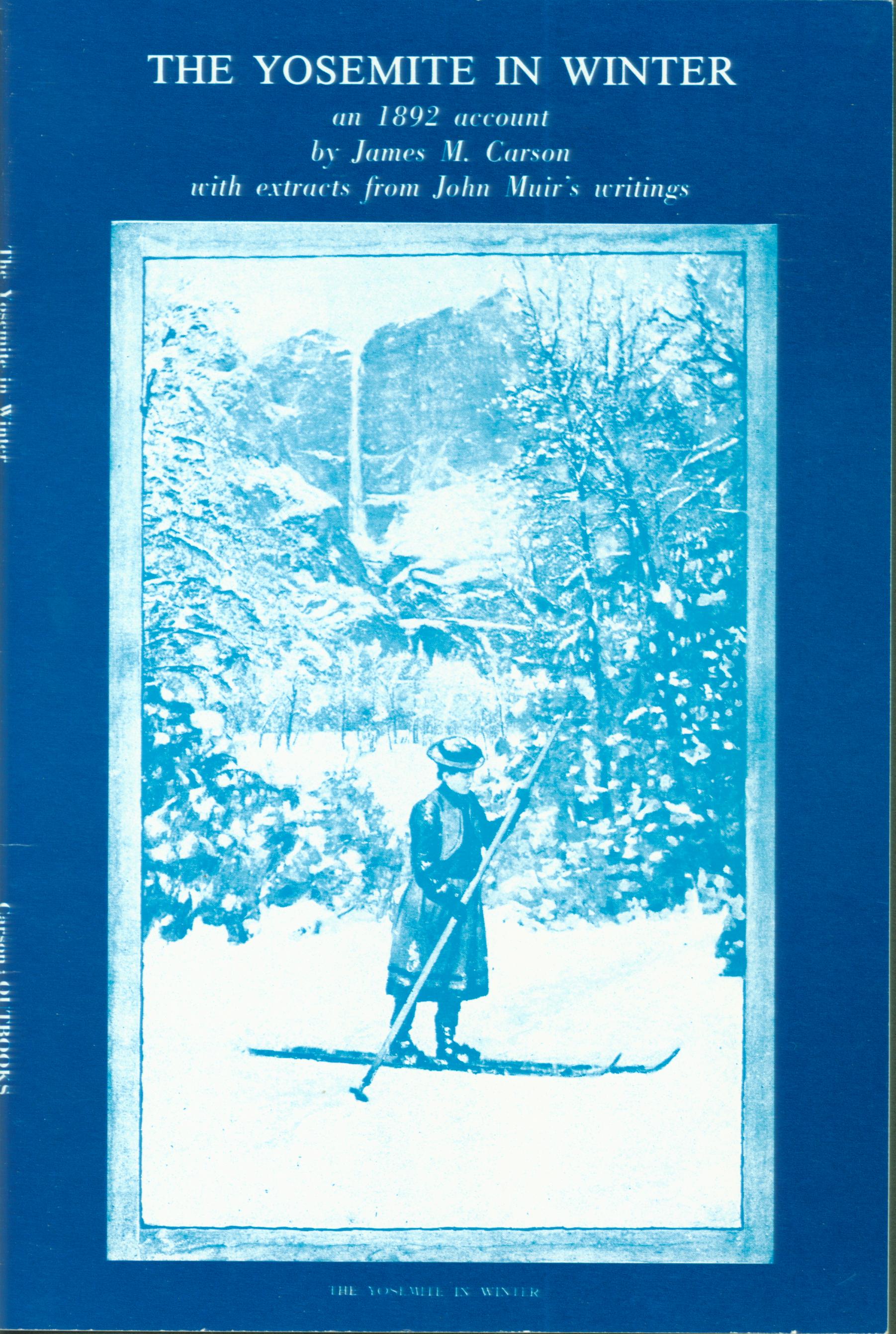 The Yosemite in Winter:
an 1892 account.
The Yosemite in Winter:
an 1892 account.
by James M. Carson, with extracts from John Muir's writings.
An appreciation of Yosemite Valley's winter character and an early history of the first winter residents, with plenty of quoted passages from John Muir, who also was a year-round valley resident in the early days. Reports of floods, in which trees were swept over the waterfalls, of the ice-cone at the base of Upper Yosemite Fall, snow-banners flying off rangecrest peaks, use of "snowshoes" (skis, today) to bring in the mail, winter-time climatic differences between north and south sides of this deep east-west trending valley due to shadows. Foreword by former Yosemite Chief Park Naturalist William Jones. Period engravings. 16 pages. See sample pages, illustrations.
ISBN-10: 0-89646-053-3. ISBN-13: 978-0-89646-053-9. Order #: VIST0053 paper$4.95.
See and hear John Muir "live" as Lee Stetson recreates John Muir memories and writings via CDs and live shows. For information, go to https://www.johnmuirlive.com.
A note about some John Muir associations: Your website author and principal of VistaBooks.com, Bill Jones, was once a Yosemite naturalist. At that time he prepared a slide show and narrative from John Muir's writings and presented it at naturalist programs in the park and sent it out in taped form to some organizations to present at their meetings. From this exposure he was invited to be the speaker at the John Muir Society annual banquet in Martinez, California. This was circa early 1960s, before establishment of the John Muir National Historic Site. He gave his talk and then listened to townsfolk speak of memories of John Muir that they had heard from old-timers. There were tales of how Muir, who was overseeing a farming operation at the time, would be the first one in the morning to the train dock to retrieve the best pallets for shipping produce before anyone else got theirs and of having great wine-filled evenings with a neighbor.
Because the trip was a distance from Yosemite, it was necessary for Bill not only to travel there but to stay overnight. In those spartan times, the park did not have travel money to support this. Instead, Yosemite National Park provided a vehicle and Bill was put up in the John Muir house itself, then owned by the Sax family, who had bought it with retirement funds, and were doing what they could to make it presentable after years of neglect. It was their hope that it would be preserved at some level of government. Thus, because there were no travel funds to pay for lodging, after the banquet Bill had the experience of sleeping in John Muir's bedroom and next morning breakfasting (prepared by the Saxes) in the house's big kitchen with monstrous stove as well as climbing up into the cupola to see the same fields that John Muir once did, although now with some houses and paved roads. A trip to the nearby family gravesite to see where Muir had been laid was also had, with reminiscences of the meanings of this man. Today you, too, can visit Muir's family home there, but sleeping in his bedroom may not be available.
Another aside is that at the Yosemite Museum where Bill worked, there were too few desks except for an old one that was said to have once been John Muir's; eventually this desk went to the John Muir House in Martinez, along with another slide show that Bill produced which was asked for by the new historical park. Artifacts in the Yosemite Museum, not always on display, are a cup Muir probably used in his Sierra wanderings and some of his notepads and sketches, including those from his first summer in the mountains, the source for his book My First Summer in the Sierra. These and other John Muir experiences perhaps led Bill to keep these of Muir's works alive and available at minimal cost for others to enjoy and understand nature, a goal that Muir had when he wrote " I care to live only to entice people to look at Nature's loveliness" (apears in Wilderness Essays).
END OF VISTABOOKS "John Muir" PAGE--click for TOP
![]() to VistaBooks Home/Contents or use links in sidebars for other pages
to VistaBooks Home/Contents or use links in sidebars for other pages
to Yosemite page
This VistaBooks "John Muir" page last revised
March 29, 2025. Did you come here from a link onanother website? For latest version of this
page, click or copy to your browser: https://www.vistabooks.com/themes/vistpubsjohn.html. Copyright © 2023 VistaBooks LLC.
Need help? email. We want you to find what you want to find.
Thanks for looking!